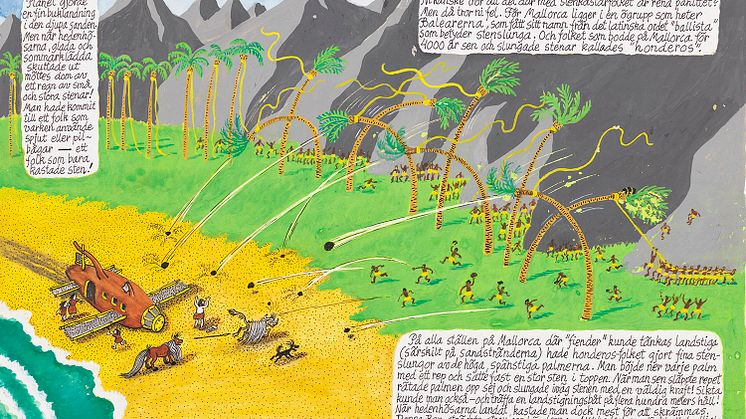
Press release -
Nationalmuseum receives major illustrative art donation
Nationalmuseum has received three donations of mid-20th-century illustrative art. Comprising some 500 works in total by Birger Lundquist, Bertil Almqvist and Allan Löthman, and covering a range of subject matter, techniques and styles typical of Swedish illustrative art of the period, the donations constitute a valuable addition to the museum’s collection.
Birger Lundquist (1910–52) was one of Sweden’s most talented 20th-century illustrators, producing thousands of illustrations during his brief career. From the 1930s up until his death, Lundquist worked at the newspaper Dagens Nyheter. As he often accompanied journalists on assignment, the donated works form a gallery of snapshots of prominent politicians, artists, writers, actors, academics and others. The portraits are drawn in the artist’s unmistakable freehand technique, using pen and ink, and are usually unsigned. The subjects, among them the politician Tage Erlander, the actors Sigge Fürst and Inga Tidblad, the designer Stig Lindberg, and the sociologist Alva Myrdal, are drawn with a sharp, insightful eye. Humour is often present, but never the exaggerated caricature typically seen in other newspaper illustrations. The donated works also include a smaller number of the artist’s book illustrations. Lundquist was a keen graphic artist as well, using the drypoint technique to create mostly portraits, and the museum has received many of the copper plates for these works.
Bertil Almqvist (1902–72) likewise worked as a newspaper illustrator, but is chiefly remembered for his much-loved series of books about the Hedenhös children, a Stone Age family. The most noteworthy pieces among the donated material are several of the original plates for Barna Hedenhös på Mallorca ‘The Hedenhös Children on Majorca’ (1969). Nationalmuseum has also received sketches for this book and others in the series, such as Barna Hedenhös reser till Egypten ‘The Hedenhös Children Go to Egypt’ (1949) and Barna Hedenhös besöker England ‘The Hedenhös Children Visit England’ (1971). Such preserved material, which provides an insight into the artist’s creative process, is rare in the field of children’s book illustration. Other donated items include a poster template for one of the most iconic Swedish images of the mid-20th century: a yellow and blue tiger created in 1941 for a propaganda campaign to encourage citizens to remain vigilant and discreet during the Second World War. Also included in the donation are illustrations for Oscar Rydqvist’s children’s book Jeppe på nya äventyr ‘The New Adventures of Jeppe’ (1930) and a selection of Almqvist’s newspaper illustrations which, like Lundquist’s, include several portraits, albeit tending more towards caricature.
Allan Löthman (1900–69) was another highly productive artist who was frequently commissioned to produce illustrations, primarily for weekly publications. Between 1923 and 1931 he lived in the United States, where he attended the Kansas City Art Institute. He created works in the spirit of American illustrators such as Howard Pyle, N.C. Wyeth and Frank Schoonover who practised during the “golden age of illustration” that lasted from the 1880s through to the 1930s. Löthman produced illustrations for adventure stories using vibrant, colourful watercolour and gouache techniques, for publication in magazines and books for boys. His works represent an important artistic link to the stylistic and narrative techniques of 19th-century narrative visual art, and especially the American illustration tradition – a tradition that remains directly and indirectly relevant to today’s pop-culture media, for instance in the fantasy and sci-fi genres. Notable items among the donated material are Löthman’s cover illustration for Pojkarnas flygbok ‘The Boys’ Book of Aviation (1937) and his meticulously executed layouts for information-rich features in the children’s magazine Kamratpostenof the 1950s and 60s: thought-provoking pictorial diagrams describing exciting historical and contemporary events. One example is the illustrations for a 1962 story on space travel and an imaginary voyage to Mars, featuring John Glenn, who that year had become the first American astronaut to orbit the Earth.
Daniel Prytz, curator at Nationalmuseum, said:
“Nationalmuseum is delighted to accept these three comprehensive donations of works by Birger Lundquist, Bertil Almqvist and Allan Löthman, all of which constitute valuable additions to our illustrative art collection, especially in the areas of children’s book illustrations and portrait illustrations from the mid-20th century.”
Nationalmuseum receives no state funds with which to acquire design, applied art and artwork; instead the collections are enriched through donations and gifts from private foundations and trusts. These three donations were generously made by Per Birger Lundquist and Kaj Richard Bernstone for Birger Lundquist, Nisse Larsson for Bertil Almqvist and Inger Unnerstad for Allan Löthman.
Inventory numbers
Birger Lundquist, Tage Erlander (1901–1985), prime minster of Sweden and Torsten Nothin (1884–1972), governor general, 1940s. Ink on paper. NMH 150/2023.
Birger Lundquist, Stig Lindberg (1816–1982), designer, illustrator and Åke Stavenow (1898–1971), art historian, 1940s. Ink on paper. NMH 174/2023.
Bertil Almqvist, “Det räcker inte att EN SVENSK TIGER” [It is not enough for a Swede to stay silent], template for the 1941 national vigilance campaign poster, 1941. Watercolour and ink on cardboard. NMH 137/2023.
Bertil Almqvist, “Planet gjorde en fin buklandning” [The plane made a nice belly landing], Barna Hedenhös på Mallorca [The Hedenhös Children on Majorca], pp. 6–7, 1969. Ink and watercolour on cardboard. NMH 26/2023.
Allan Löthman, Pojkarnas Flygbok 1937 [The Boys’ Book of Aviation 1937], cover, 1937. Watercolour on cardboard. NMH 1/2023.
Allan Löthman, “Tur-retur Mars” [Return flight to Mars], John Glenn (1921–2016), Kamratposten, No. 13, 1962, 1962. Watercolour and ink on cardboard. NMH 5/2023.
Media contacts
Daniel Prytz, curator, daniel.prytz@nationalmuseum.se, +46 8 5195 4306
Hanna Tottmar, head of press, press@nationalmuseum.se, +46 8 5195 4400
Categories
Nationalmuseum is Sweden’s museum of art and design. The collections comprise some 700 000 objects, including paintings, sculpture, drawings and graphic art from the 16th century up to the beginning of the 20th century and the collection of applied art and design up to the present day. Nationalmuseum is a government authority with a mandate to preserve cultural heritage and promote art, interest in art and knowledge of art.

